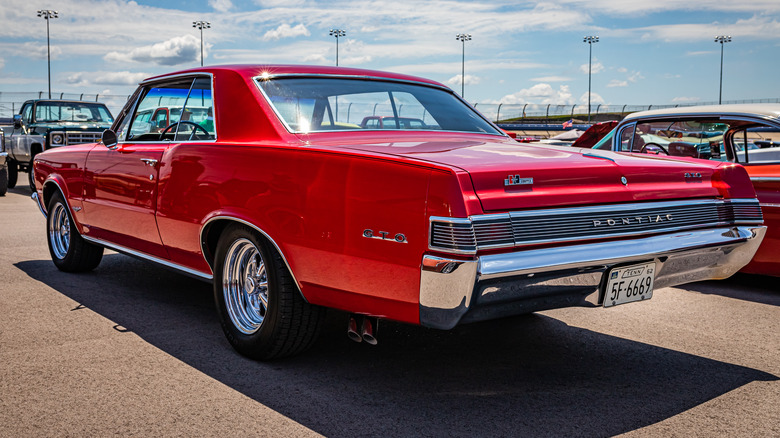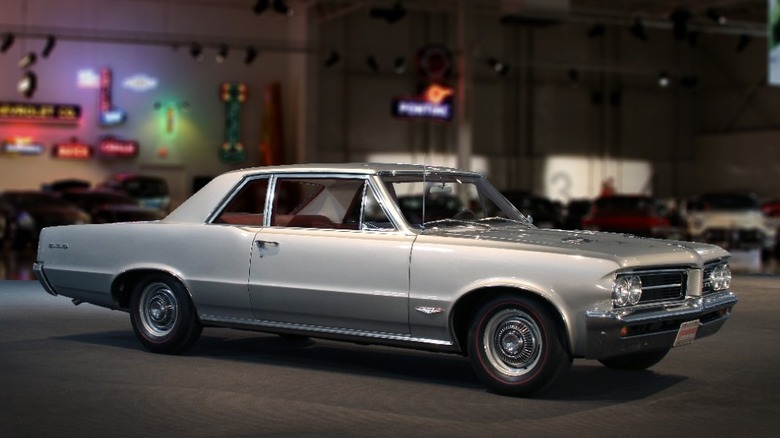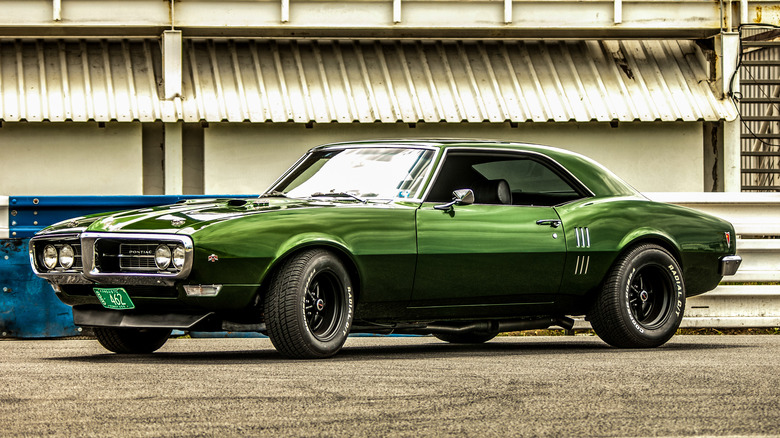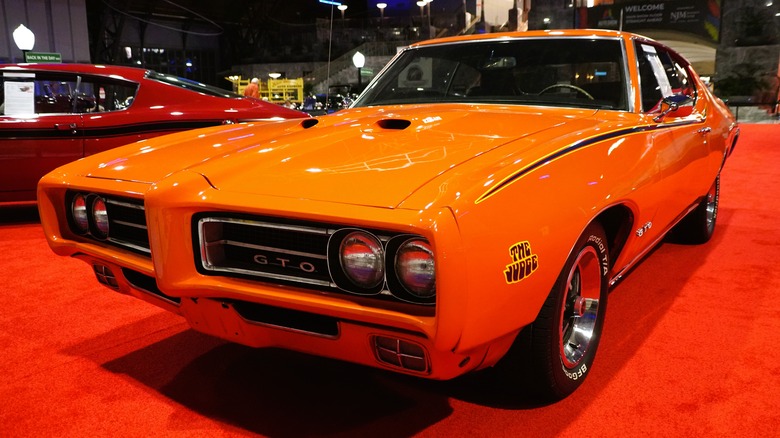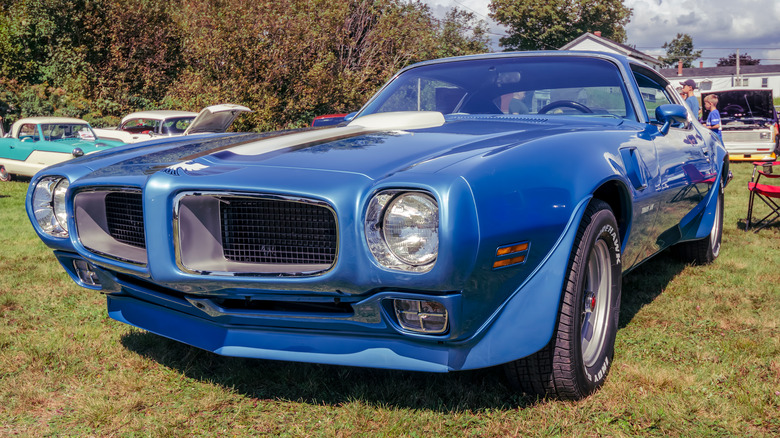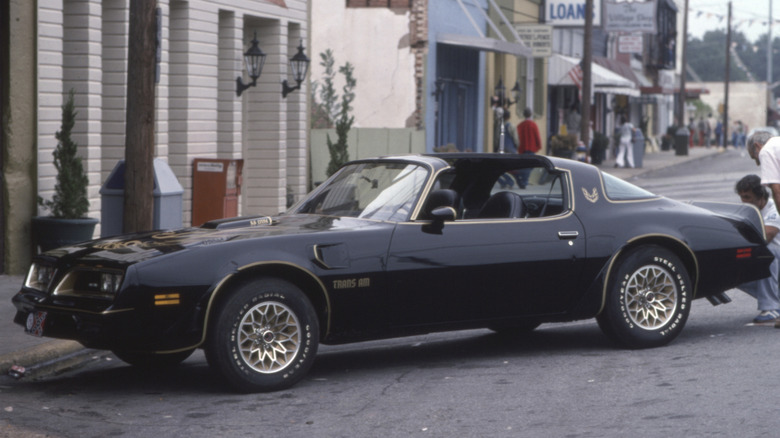5 Of The Coolest Looking Classic Muscle Cars Pontiac Ever Made
Pontiac had a very good run during the classic muscle car era. It was a time when Detroit's auto-making divisions were focused on stuffing high performance engines into great-looking packages. While some car experts believe that the 1949 Oldsmobile Rocket 88 was one of the first muscle cars, and others cite the Hemi-powered 1955 Chrysler C-300, Pontiac created the 1960s muscle car when it came out with the 1964 Tempest Le Mans GTO. The company continued to make its mark during the years of the muscle car wars, with several of the coolest-looking classic models.
Pontiac's muscle car history grew out of its involvement in NASCAR racing. After increasing the size of its largest production-car V8 to 389 cubic inches in 1959, the company developed a high-performance Super Duty version the following year. The 389 Super Duty had three two-barrel carbs and put out 348 horsepower. Pontiac racers put this engine to good use, winning 30 out of 54 NASCAR races by the end of 1961.
Pontiac's next step toward muscle car fame resulted from the confluence of several factors: John Z. DeLorean became Chief Engineer, NASCAR required the car companies competing in its race series to offer their go-fast parts in production cars, the baby boomer generation were coming of driving age, and a recession in 1960-61 drove consumers into smaller, less-expensive vehicles. The stage was set for the muscle car to make its entrance – and Pontiac made the first move.
1964 Pontiac Tempest Le Mans GTO
This Pontiac was the first of the 1960s muscle cars. With a 389 cubic-inch V8 that was similar to the 1960 NASCAR engine, the 1964 Pontiac Tempest Le Mans GTO was the forerunner of the muscle car formula: Dropping the largest engine into the smallest-bodied vehicle equals high performance.
The 1964 Pontiac GTO breaks down like this – Le Mans is the top trim level of Pontiac's midsize car, the Tempest, with the GTO option. Styling of the GTO was similar to Pontiac's larger, successful, and cool-looking Grand Prix model. The GTO was available as a two-door coupe, hardtop, or convertible.
The GTO started with the 389 block that was also used in the Grand Prix and added the heads from the larger 421 H.O. engine. A high-lift camshaft and specific hydraulic valve lifters were also added. The compression ratio was 10.4:1, which required premium gas. When combined with three two-barrel Rochester carburetors, known as the Tri-Power engine, this mill put out 348 horsepower and a stump-pulling 428 lb-ft of torque. Of the 32,450 Tempest Le Mans GTOs sold, only 8,245 had the Tri-Power.
The GTO package included features that provided a balance of straight-line performance and cornering ability. GTOs had a stiffer suspension with upgraded shocks, and a thicker front anti-roll bar, wider wheels with low-profile, high-performance tires, and an upgraded clutch on manual-transmission cars. The transmission options included a three-speed manual, either a wide- or close-ratio four-speed manual, or a two-speed automatic.
1967-68 Pontiac Firebird
The 1967-68 Pontiac Firebird was based on the same platform as the Chevrolet Camaro. However, Pontiac designers made the Firebird their own, thanks to the cool-looking bright chrome wraparound bird beak on the front, the louvers stamped into the rear fenders, the slatted taillights at the rear, and a more luxurious options list.
Even though the Firebird followed the Camaro into the marketplace five months later, it took advantage of some lessons learned during the Camaro's launch. As a result, the Firebird's engine was moved farther back in the chassis for better weight distribution and handling, while traction bars were made standard to reduce axle windup during aggressive starts.
The Firebird also came in five trim levels compared to the Camaro's four, the top three of which signaled V8-powered muscle car performance. For 1967, the mildest of the three was the Firebird 326 with 250 horsepower. Next was the Firebird 326 H.O. with 285 horsepower. The top of the line was the Firebird 400 with 325 horsepower, which could be boosted to 335 horsepower with the L67 Ram Air package. In 1968, the 326 grew to a 350, a 400 H.O. version was added, and all V8 engines except for the Ram Air saw power increases.
1969-71 Pontiac GTO Judge
The GTO Judge is a cool-looking muscle car that was developed to extend the Pontiac GTO's life, but while it was a great car in its own right, it ultimately could not save the GTO name from oblivion. The Judge was an option package initially intended to be offered only in 1969, but was later extended for the 1970 and 1971 model years. The Judge came with the unique Carousel Red paint — actually orange, the rear spoiler, a Hurst shifter on manual-transmission models, the Judge decals, and body stripes to match. Powering the Judge was one of two Pontiac 400 cubic-inch engines: The 366-horsepower Ram Air III or the 370-horsepower Ram Air IV.
The Judge got its name from the popular television skit "Here Comes The Judge," performed on "Rowan and Martin's Laugh-In" show during the late 1960s. The Judge was available as either a hardtop or a convertible, but only 108 convertibles were sold compared to 6,725 hardtops, in 1969. Production dwindled after that, with some arguing that this marked the beginning of the end of the muscle car era.
1970 1/2 Pontiac Firebird Trans Am
The 1970 1/2 Pontiac Firebird Trans Am was originally intended to be a 1970 model, but the new cars were delayed by a massive labor strike and tooling issues at GM. Their late production start led them to be called 1970 1/2 models.
The new Trans Am was the Firebird's top trim level, designed for all-out performance. Powered by Pontiac's 400 cubic-inch Ram Air III with 345 horsepower, the Trans Am came with a four-speed manual transmission, limited-slip differential, variable-ratio power steering, special shocks and springs, spoilers front and rear, fender air extractors, a shaker hood scoop, and an engine-turned instrument panel. The Trans Am was initially available only in two color combinations: Blue with white stripes or white with blue stripes.
This Trans Am was a big hit with the motoring press, but a combination of high insurance premiums, emissions regulations, and a tough economy caused both Trans Am and Firebird sales to dwindle. Despite this, the true believers at Pontiac kept the Trans Am in production, which made the success of the next cool-looking classic Pontiac muscle car possible.
1977 Pontiac Firebird Trans Am
While this Pontiac Trans Am muscle car is cool-looking in its own right, its street cred went through the roof after a starring appearance in the 1977 hit movie "Smokey and the Bandit." Due to the timing of the film, the newly-restyled 1977 models were not available, so the production received four 1976 Trans Ams that had been updated by Pontiac with 1977 body parts, so that the latest Trans Am model could be promoted in the movie. The Bandit model was a Trans Am LE, black with gold trim, with T-tops and the large firebird on the hood. The 1977 Pontiac Trans Am engine choices included a 400 cubic-inch V8 with 180 horsepower, a California-legal 403 cubic-inch V8 with 185 horsepower, or a 400 cubic-inch V8 called the T/A 6.6 with 200 horsepower.
Of the four Trans Ams given to the production, three were destroyed during filming, with the fourth car in such bad shape that it had to be pushed into position for shooting. However, the exceptional product placement did wonders for Trans Am sales.
